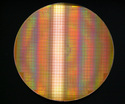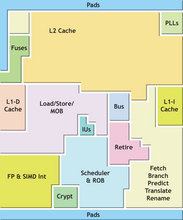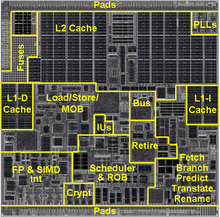Via launches 64-bit architecture
Jan 23, 2008 — by LinuxDevices Staff — from the LinuxDevices Archive — 3 views Via has unveiled a 64-bit, VM-enabled x86-compatible architecture expected to debut this spring in pin-compatible chips targeting green PCs, home servers, and mobile devices. Chips based on the “Isaiah” architecture promise to outperform Via's current C7/Eden chips two-to-three times, within the same power… envelope.
Via has unveiled a 64-bit, VM-enabled x86-compatible architecture expected to debut this spring in pin-compatible chips targeting green PCs, home servers, and mobile devices. Chips based on the “Isaiah” architecture promise to outperform Via's current C7/Eden chips two-to-three times, within the same power… envelope.
(Click for larger view of an Isaiah wafer)
digg this story |
Via has no plans to discontinue its C7 and Eden chip lines, which are based on the Esther architecture. Instead, initial Isaiah-based chips will add a higher performance but pin-compatible option, at a higher price-point. This approach will let customers address a wide range of price and performance points with a single design, Via suggests.
Through the years, Via has had an excellent track record for delivering new processors at regular intervals. Its Austin, Tex. based CenTaur chip unit claims to have delivered approximately seven major chip designs since being acquired by Via in mid-1999. However, Isaiah is a little bit behind schedule, having been first announced in 2004, with an original target delivery date in 2006.
Initial Isaiah-based chips will be built on 65 nanometer process technology. They will clock to 2GHz, Via expects, and offer FSB speeds from 800MHz to 1333MHz. They will have 64KB each of L1 instruction and data cache, and 1MB of exclusive L2 cache with 16-way associativity. Additionally, Isaiah chips will feature the “world's fastest” (relative to clockspeed) floating-point unit, addressing an area of traditional weakness in Via chips — multimedia computation.


Isaiah function block diagram and die plot
(Click either to enlarge)
Isaiah's superscalar, speculative out-of-order microarchitecture invites comparison with the Core2 micro-architecture used across Intel's line of mobile, desktop, and server chips. Additionally, Isaiah's 64-bit support is compatible with Intel's, while its virtual machine (VM) architecture is compatible with Intel's VTX, which Via has licensed. There are differences, though. Core2's L2 cache is inclusive, and Core2 has smaller L2 caches.
Intel, meanwhile, expects to move down-market with its Silverthorne processor, also expected to debut this spring. Silverthorne uses an in-order architecture, much like Via's Esther architecture, and targets the same mobile and consumer markets where Via has achieved much of its success to date.
 Glenn Henry (Click for the interview) |
So, how will the competition shape up, and what's Isaiah all about? We asked this and other questions of Glenn Henry (pictured), the IBM fellow who leads CenTaur. Click below to read our interview with Henry.
This article was originally published on LinuxDevices.com and has been donated to the open source community by QuinStreet Inc. Please visit LinuxToday.com for up-to-date news and articles about Linux and open source.